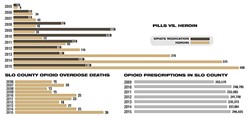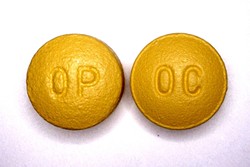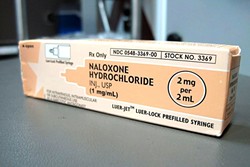[{
"name": "Newsletter Promo",
"id": "NewsletterPromo",
"class": "inlineCenter",
"insertPoint": "4",
"component": "15264767",
"requiredCountToDisplay": "0"
},{
"name": "Ad - Medium Rectangle CC01 - 300x250",
"id": "AdMediumRectangleCC01300x250",
"class": "inlineCenter",
"insertPoint": "8",
"component": "2963441",
"requiredCountToDisplay": "12"
},{
"name": "Ad - Medium Rectangle LC01 - 300x250",
"id": "AdMediumRectangleCC01300x250",
"class": "inlineCenter",
"insertPoint": "18",
"component": "2963441",
"requiredCountToDisplay": "22"
},{
"name": "Ad - Medium Rectangle LC09 - 300x250",
"id": "AdMediumRectangleLC09300x250",
"class": "inlineCenter",
"insertPoint": "28",
"component": "3252660",
"requiredCountToDisplay": "32"
}]
What does a drug addict look like?
For most people, the words conjure up images gaunt and hollowed-eyed men and women in dirty clothes, ragged and shaking on the sidewalks of massive metropolitan cities. It’s an image more likely cribbed from old episodes of The Wire or Law and Order than from real life.
But Lois Petty knows better.
“They have this movie idea of what an addict is,” she said.
Petty is a communicable disease investigator for SLO County Public Health Department and the site manager for San Luis Obispo County’s lone syringe exchange program. Operating one night a week in SLO city, staffed by volunteers, and funded entirely by grants and donations, the program allows intravenous drug users to safely exchange used needles for clean ones, get tested for HIV and hepatitis C, and get information about drug treatment options. Last year the clinic logged more than 1,400 visits from 487 unique clients and exchanged or collected more than 160,000 syringes.
That’s all to say that Petty, who’s been with the exchange since it began in 2006, has seen and interacted with a lot of individuals struggling with drug addiction. She knows there are perceptions about who an addict is, and she’s aware of how much those assumptions can differ from reality. People struggling with addiction come from all walks of life. She noted that she’s seen people pull up to the syringe exchange site in BMWs.
“People stereotype what an addict is,” she said. “You’d be surprised who shows up on our doorstep.”
And while the types of people battling drug addiction in SLO County might be a more diverse cross section of society than most think, many of the clients Petty and her fellow volunteers serve each week at the exchange are addicted to or abusing a single type of drug. Opioids.
Between opioid prescription drugs like oxycodone and street narcotics like heroin, nearly 75 percent of the exchange’s clientele reported using some form of opioid. The startling numbers have grown over the years and are just one symptom of what some are describing as an epidemic of opioid abuse that’s swept not just SLO County, but also the entire country.
“It’s out there,” Petty said. “And no community is immune from it.”
Disturbing data
As part of its operation, the syringe exchange program collects information and data from its clients. The data can function as a sort bellwether for drug-use trends in SLO County. Opioid abuse has been a growing concern since at least the early 2000s, when the popular and highly addictive pain medication Oxycontin hit the consumer market. Petty said the exchange began to see a significant increase in clients self-reporting that they had used opioid drugs over the last few years.
“About three years ago, it was pretty clear there was a big uptick,” she said.
Petty and the volunteers at the exchange aren’t the only ones tracking the rising tide of opioid abuse and addiction in the county, nor are they the only ones who are alarmed at the size and scope of the problem. Ann McDowell is an epidemiologist with SLO County’s Public Health Department. She’s been gathering and analyzing data on behalf of the SLO Opioid Safety Coalition, a group of representatives from various nonprofit organizations, health care and medical professionals, and local government entities that have come together to tackle the opioid problem. At one of the commission’s meetings in October 2016, McDowell presented a set of comprehensive data on the opioid problem. The numbers revealed what many at the meeting had known for some time: The crisis was large in scope and increasing.
“We have a problem in this county, and it’s getting worse,” McDowell said.
According to the data, the number of opioid-related deaths in SLO County was increasing. Over a 10-year period, the county reported 211 total opioid overdose deaths. The number of deaths more than doubled in that period, rising from 15 in 2006 to 36 in 2015. The number of deaths increased by 11 in 2015, the largest spike in the entire 10-year period.
“We can see the number of deaths through prescription use is going up,” McDowell told New Times. “I don’t want to say the problem has peaked, but the number of deaths continues to climb.”
It isn’t just deaths that are increasing. The data collected by the coalition also showed a rise in opioid-related emergency room visits for the same period of time. In 2006 there were just 65 such visits, compared to 111 in 2015. Similar to the deaths, one of the largest increases in those visits occurred in 2015, which saw 31 more visits than the previous year.
“The numbers are going up, which means that we’ve not yet stopped the problem,” McDowell said.
The problem goes beyond the county’s emergency rooms and hospitals, bleeding into other facets of life. According to data from the San Luis Obispo County Sheriff’s Office, hundreds of arrest-related urine samples have tested positive for opioids. Of the samples taken in 2014 and 2015, 37 percent tested positive for codeine, hydrocodone, or oxycodone. An estimated 43 percent of the samples tested positive for morphine. Those numbers mean that many of those same individuals experience the symptoms of opiate withdrawals after being booked into county jail, according to Katie Dolezal, a nurse practitioner with SLO County’s Drug and Alcohol Services Department.
“Within 24 to 48 hours, they are in our jail program, and they are sick,” she told attendees at Opioid Safety Coalition’s October meeting.
From county jails to the classroom, there seems to be no place the problem of opioid abuse hasn’t touched. The data collected by McDowell included the results of the California Healthy Kids Survey, which showed that 16 percent of the SLO County 11th grade students who took the survey reported that they’d used prescription opioids, tranquilizers, or sedatives recreationally at least once in their lifetime.
The spread of the problem isn’t unfamiliar to an epidemiologist like McDowell, but unlike the flu or common cold, the nature of the county’s struggle with opioids is interconnected with a host of complex issues, from socioeconomics and drug industry regulations, to criminal justice, psychology, and more.
Identifying the root cause can be difficult, but the coalition’s data revealed one of the epidemic’s major sources: a flood of prescriptions for opioid medication.
Bad medicine
The rise in SLO County residents dying, overdosing, or seeking treatment because of opioid abuse occurred amid a boom in the number of prescriptions for powerful pain medication. Between 2009 and 2015, the number of opioid prescriptions written in SLO County grew by 20 percent, according to data the coalition obtained from California’s Controlled Substance Utilization Review and Evaluation System, or CURES, a database that regulatory agencies and law enforcement use to track the distribution of controlled substances like opioid painkillers.
McDowell said the sheer number of opioid prescriptions being written in the county shocked her. According to the CURES data, there were 246,665 prescriptions for opioid medication written in 2015 alone in SLO County. The total population for the entire county that same year was 281,401.
“That’s almost one prescription for every man, woman, and child in the county,” McDowell said.
Until September 2016, licensed practioners like doctors, nurses, and others in California were required to enroll in the CURES database, but were not required actually use it to check the prescription history of a patient. The lack of that requirement allowed individuals to seek out multiple doctors, hospitals, and other care providers to obtain multiple opioid prescriptions. That appears to be the case in SLO County. A six-month snapshot of the county, using CURES data, showed that an average of 19.7 per 1,000 residents in Santa Margarita were using six or more providers or pharmacies to obtain opioid prescriptions. In Morro Bay that average was 20 residents per 1,000. Pismo Beach had the highest average rate, with 21 resident per 1,000.
While it might be easy to point the finger at physicians and health care providers over-prescribing pain medication, even those who try to be diligent and keep patients from “doctor shopping” face numerous challenges. Dr. Stefan Tetgie, an emergency room physician in Arroyo Grande, works with the coalition. Speaking at the October meeting, Tetgie noted that different doctors, health care providers, and medical clinics use different computer and charting systems, making it difficult if patients decide to switch or move around in the system.
“They aren’t all bad. Opiates serve a purpose in the treatment of acute pain,” he told the other coalition members. “Unfortunately, patients are being passd around from group to group to group.”
A recently passed state law may help curb the problem. In September 2016, Gov. Jerry Brown signed a new bill that requires all prescribers issuing power painkillers, including opioids, to consult with the CURES system before prescribing. State Sen. Ricardo Lara (D-Bell Gardens), who authored the bill, believes it could be an effective method for curbing California’s struggle with opioid abuse and addiction.
“I’ve met families across California who lost their mothers, fathers, sons, daughters, and friends to the prescription drug abuse epidemic, and it is truly heartbreaking,” Lara said in a statement issued shortly after Brown signed his bill into law. “This law will play a critical role in curbing the excess prescribing and keeping prescription drugs out of the hands of those who abuse them.”
The law won’t take effect until six months after the state’s Department of Justice signs off on its provisions.
Even as doctors and lawmakers try to clamp down and get a handle on the spread of prescription opioid abuse, users are already beginning to migrate to an illegal street drug that’s just as addictive and dangerous.
Heroin, fentanyl, and overdoses
A national spike in the use and abuse of heroin followed in the wake of the boom in prescription opiates. According to the U.S. Centers for Disease Control (CDC), heroin use increased more than 286 percent over a 10-year period between 2002 and 2013. Nearly 45 percent of individuals who used heroin were also addicted to opioid painkillers.
SLO County hasn’t been spared from the trend. In mid-2011, the number of individuals seeking drug treatment within the county for heroin use outpaced the number of those seeking treatment for opioid medication abuse. In 2015, while 138 residents sought treatment for abuse of opioids like codeine and Oxycontin, nearly 400 sought treatment for heroin. Ten years prior, only five people sought treatment for heroin in the county, according to the coalition’s data. An estimated 21 percent of arrest-related urine samples tested positive for heroin between 2014 and 2015.
And even as concerns over heroin remain acute, worries about the synthetic opioid fentanyl, which the CDC states is 50 to 100 times more potent than morphine, are beginning to surface in SLO County.
“Fentanyl is scaring the bejesus out of us,” county Drug and Alcohol nurse Dolezal said at the October Opioid Safety Coalition meeting.
Syringe exchange program site manager Petty also indicated there’d been whispers about the powerful drug’s use.
“We’ve had reports of fentanyl in the area; … it’s just sporadic,” she said.
With the rising use of opioids and heroin, overdoses remain a grave concern. The CDC’s data shows that many opioid users also use additional drugs, making the possibility of serious injury or death due to overdose even greater.
According to data collected by the syringe exchange, more than 51 percent of the program’s participants said they’d experienced an overdose.
A need to prevent opioid deaths led members of the coalition to try to increase the availability of, training for, and use of naloxone, a medication created specifically to reverse opioid overdoses. In 2015, SLO County EMS workers reported 74 instances when a patient overdosing on opioids responded positively to naloxone. For the last year, the syringe exchange program has included naloxone in the kits it hands out to clients.
“We actually train the patients how to use the naloxone,” Petty said.
Working for change
While the problem of opioid abuse and addiction in SLO County is widespread and complex, that hasn’t stopped a dedicated group of concerned advocates from taking it on.
As of its Jan. 19 meeting, the SLO Opioid Safety Coalition will mark the end of its first year. Much of its work in 2016 was spent gathering data, raising awareness, and bringing together a wide range of government agencies, health care providers, nonprofit organizations, and individuals to find out the true scope of the problem and set goals for how to fight the epidemic. The organization was one of the first 12 such coalitions created in California.
“What we have done in this short time is phenomenal,” SLO County Health Officer Dr. Penny Borenstein said at the October meeting.
While the road to reversing the troubling upward trend of opioid abuse will be an uphill climb, there are some promising signs. Since they began including naloxone in their syringe kits, the exchange program has reported that at least 70 percent of them had been used to successfully prevent an overdose.
The coalition trained eight overdose prevention educators in the county’s drug and alcohol outpatient and jail services. Dolezal indicated that a group is also trying to create a program to provide medical-assisted treatment program for opioid addiction within the county jail system, creating a continuum of care to keep inmates who detox in custody from relapsing when they are released.
In addition, the CVS pharmacy in Nipomo now offer naloxone, and two CVS pharmacies, one in SLO and one in Grover Beach, have completed the necessary training to prescribe naloxone to customers.
While there is no silver bullet to end what appears to be a massive, far-reaching, and deadly problem, each small victory represents some progress, and many times, a life saved.
“It gives people the chance to see the sun rise again,” Petty said.
Staff Writer Chris McGuinness can be reached at [email protected], or on Twitter at @CWMcGuinness.
Latest in News
Readers also liked…
-

Coast Unified teachers upset over new position's salary and qualifications
Oct 20, 2022 -

SLO police identify alleged driver who hit and killed couple
Dec 22, 2022 -

When the levee breaks: Oceano residents, county officials walk a tightrope of regulations to manage Arroyo Grande Creek, which some say led to the levee's failure in January
May 18, 2023














